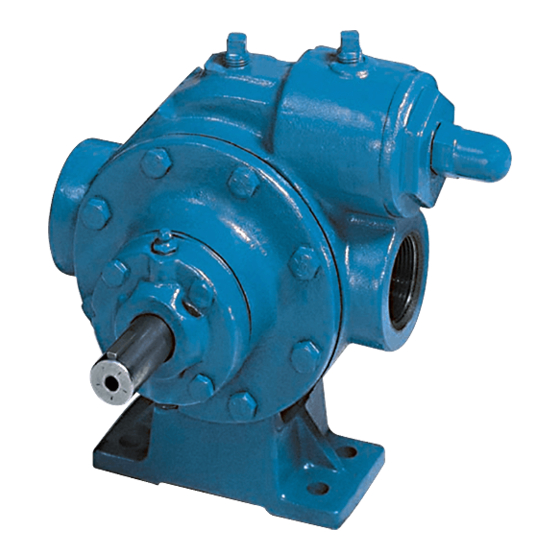Dover BLACKMER CRLR1.25 Instructies voor installatie, bediening en onderhoud - Pagina 5
Blader online of download pdf Instructies voor installatie, bediening en onderhoud voor {categorie_naam} Dover BLACKMER CRLR1.25. Dover BLACKMER CRLR1.25 12 pagina's. Blackmer liquefied gas pumps

Operation without guards in place can
cause serious personal injury, major
property damage, or death.
Do not operate
without guard
in place
Failure to relieve system pressure prior
to performing pump service can cause
serious personal injury or property
damage. Systems with meters will still
be pressurized even after the hose is
Hazardous pressure
emptied
can cause serious
personal injury or
property damage
PRE-START UP CHECK LIST
1.
Check the alignment of the pipes to the pump. Pipes
should be supported so that they do not spring away or
drop down when pump flanges or union joints are
disconnected.
2.
Verify coupling alignment.
3.
SLOWLY build pressure in the pump, then check the
entire pumping system to verify that the proper inlet and
discharge valves are fully open, and that the drain valves
and other auxiliary valves are closed.
4.
Install suction and discharge pressure gauges on the
pump in the threaded connections provided. These can
be used to check actual suction and discharge conditions
after pump start-up.
5.
Check the wiring of the motor.
6.
Briefly start the pump to verify proper rotation direction.
START UP PROCEDURES
NOTICE:
Consult the "General Pump Troubleshooting" section of
this manual if difficulties during start up are experienced.
1.
SLOWLY build pressure in the pump.
2.
Start the pump. Priming should occur within one minute.
3.
Check the suction and discharge pressure gauges to see
if the pump is operating within the expected conditions.
4.
Check for leakage from the piping and equipment.
5.
Check for excessive noise, vibration or overheating of the
pump, reducer, and motor.
6.
If possible, check the flow rate.
7.
Close the discharge valve and check the differential
pressure across the pump. Pressure must not exceed the
pressure setting of the external bypass valve.
8.
With the discharge valve still closed, momentarily close
the manual shut-off valve in the bypass return line to
check the pump relief valve. The pressure should be at
least 25 psi (1.7 bar) higher than the maximum system
operating pressure or the system pressure control valve
setting. If adjustments need to be made, refer to "Relief
Valve Setting and Adjustment" section of this manual.
OPERATION
Hazardous pressure
can cause serious
personal injury or
property damage
Hazardous pressure
can cause personal
injury or property
damage
9.
The external bypass valve must be set at least 25 psi
(1.7 bar) lower than the internal pump relief valve. NOTE:
The normal operating pressure must be at least 5 - 15 psi
(0.3 -1.0 bar) less than the external bypass valve setting.
Pump speeds which result in higher pressures (nearing
the valve setting) forces the liquid to be recirculated,
creating excessive wear on the pump and equipment.
RELIEF VALVE SETTING AND ADJUSTMENT
The relief valve pressure setting is marked on a metal tag
attached to the valve cover. Generally, the relief valve should
be set at least 15 - 20 psi (1.0 - 1.4 Bar) higher than the
operating pressure, or the external bypass valve setting.
DO NOT remove the R /V Cap OR adjust the relief valve
pressure setting while the pump is in operation.
1. To INCREASE the pressure setting, remove the relief
valve cap, loosen the locknut, and turn the adjusting
screw inward, or clockwise. Replace the valve cap.
2. To DECREASE the pressure setting, remove the relief
valve cap, loosen the locknut, and turn the adjusting
screw outward, or counterclockwise. Replace the valve
cap.
Refer to the individual Blackmer pump parts lists for various
spring pressure ranges.
Hazardous pressure
can cause personal
injury or property
damage
Hazardous or toxic
fluids can cause
serious injury.
701-A00
Page 5/12
Disconnecting fluid or pressure
containment components during pump
operation can cause serious personal
injury or property damage.
Pumps operating against a closed valve
can cause system failure, personal
injury and property damage
Incorrect settings of the pressure relief
valve can cause pump component
failure, personal injury, and property
damage.
Relief valve cap is exposed to pumpage
and will contain some fluid
